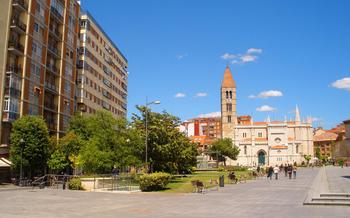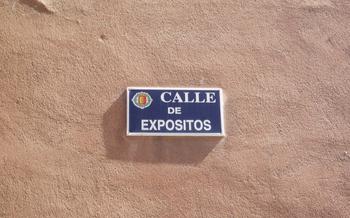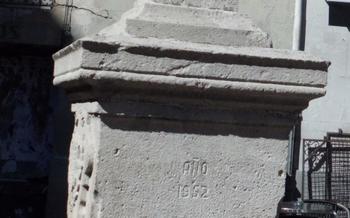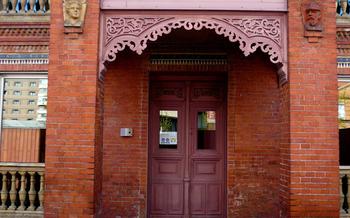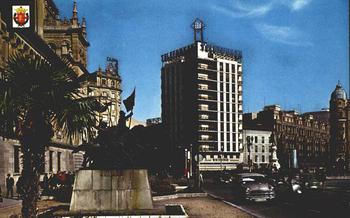
Palacio de Santa Cruz
- A Timeless Masterpiece: The Building's History
- A Space for Knowledge and Culture
- Navigating the Palace: A Visitor's Guide
- Unveiling the Secrets of the Facade
- Exploring the Interior's Grandeur
- A Walk Through History: The University's Legacy
- Cultural Events and Exhibitions: A Vibrant Space
- A Stroll Through the Neighborhood: Exploring Valladolid
- Practical Tips for a Memorable Visit
- Unveiling Hidden Gems: Secret Corners of the Palace
- Beyond the Palace: Exploring Valladolid's Charm
- Insider Tip: Discovering the Secret Courtyard
A Timeless Masterpiece: The Building's History
The Palacio de Santa Cruz's story begins in 1487 when Cardinal Juan de Torquemada, a prominent figure in the Spanish Inquisition, founded the College of Santa Cruz. Initially intended as a college for the education of the clergy, it quickly gained recognition for its academic excellence, attracting students from all over Spain.
In the 16th century, the college underwent a significant transformation, evolving into the renowned University of Valladolid. This prestigious institution, one of the oldest in Spain, played a pivotal role in shaping the intellectual and cultural landscape of the country. Throughout its history, the university has educated countless notable figures, including Miguel de Cervantes, the author of the iconic novel "Don Quixote," and José Zorrilla, a renowned playwright and poet.
In the 19th century, the university relocated to a new campus, leaving the Palacio de Santa Cruz vacant. Recognizing its historical and architectural significance, the regional government of Castile and León decided to repurpose the building, transforming it into the seat of its headquarters. This decision ensured that the Palacio de Santa Cruz would continue to serve as a vital institution, contributing to the governance and administration of the region.
Adding to the allure of the Palacio de Santa Cruz is a captivating legend that has been passed down through the centuries. It is said that the ghost of a monk haunts the building's corridors, a ghostly apparition that is believed to be the spirit of a former student who met an untimely demise within the palace walls. This legend adds an element of mystery and intrigue to the building's already rich history, captivating the imaginations of visitors and locals alike.
A Space for Knowledge and Culture
The Palacio de Santa Cruz is not just a historical and architectural marvel; it is also a vibrant center of knowledge and culture. Since its inception as a college in the 15th century, the building has served as a prestigious educational institution, evolving into the renowned University of Valladolid. Over the centuries, the university has fostered a rich legacy of academic excellence, shaping the intellectual landscape of Spain. Its illustrious alumni include literary giants such as Miguel de Cervantes, author of the seminal work "Don Quixote," and the renowned poet José Zorrilla.
The university continues to uphold its commitment to education and cultural enrichment, hosting a variety of events and exhibitions throughout the year. These events showcase the diverse talents of local, national, and international artists, providing a platform for artistic expression and fostering cultural dialogue. The Palacio de Santa Cruz also houses the Biblioteca Universitaria, a treasure trove of knowledge that safeguards a vast collection of books, manuscripts, and historical documents. This library is a sanctuary for scholars and researchers, offering access to rare and valuable texts that illuminate the past and inspire future generations.
Navigating the Palace: A Visitor's Guide
Before embarking on your visit to the Palacio de Santa Cruz, it is essential to plan your trip to make the most of your experience. Here's some practical information to help you navigate the palace:
-
Opening hours: The Palacio de Santa Cruz is typically open to the public from Tuesday to Sunday during specific hours. It is advisable to check the official website or contact the palace directly for the most up-to-date information on opening hours, as they may vary depending on the season or special events.
-
Admission fees: Admission to the Palacio de Santa Cruz is free of charge. However, certain areas, such as the Rector's Hall or the Chapel, may require a small entrance fee. It's worth checking with the palace staff or the tourist information office for specific details.
-
Guided tours: Guided tours of the Palacio de Santa Cruz are available for a more in-depth exploration of its history and architecture. These tours are typically conducted in Spanish, but English-language tours may be arranged upon request. It's advisable to book your tour in advance to secure a spot, especially during peak tourist season.
-
Accessibility: The Palacio de Santa Cruz is committed to providing accessibility to all visitors. The palace is wheelchair-accessible, and there are ramps and elevators to facilitate movement throughout the building. If you have any specific accessibility requirements, please contact the palace staff in advance to ensure your needs are met.
Unveiling the Secrets of the Facade
The main entrance of the Palacio de Santa Cruz is a sight to behold, with its intricate carvings and a coat of arms proudly displayed. Step into the central courtyard, surrounded by elegant arches and adorned with a Renaissance fountain. Gaze up at the impressive tower, offering panoramic views of Valladolid from its top. Admire the exquisite sculptures and carvings that adorn the facade, depicting biblical scenes and mythological figures, each one a testament to the skill and artistry of the craftsmen who created them.
Exploring the Interior's Grandeur
Beyond its impressive facade, the Palacio de Santa Cruz boasts an equally captivating interior, showcasing a blend of architectural styles and significant historical spaces. Step into the Rector's Hall, a stunning chamber adorned with intricate carvings and elaborate ceiling frescoes. Here, the university's most important ceremonies and events take place.
Visit the Assembly Hall, where the university's governing body meets to make crucial decisions that shape the institution's future. Admire the beautiful chapel, a sanctuary of peace and devotion, featuring exquisite stained-glass windows and religious artworks that inspire contemplation.
Don't miss the university's library, a treasure trove of knowledge and scholarship. Its vast collection of books, manuscripts, and historical documents offers a glimpse into the rich intellectual heritage of the university and the region. Immerse yourself in the world of academia as you explore this repository of knowledge.
A Walk Through History: The University's Legacy
The University of Valladolid, housed within the Palacio de Santa Cruz, holds a rich and storied history dating back to the 13th century. Founded as a Studium Generale, it quickly rose to prominence as one of Spain's leading educational institutions. Over the centuries, the university has played a pivotal role in shaping Spanish education and culture, producing notable figures who have left an indelible mark on various fields.
One such figure is Fray Luis de León, a renowned poet, theologian, and professor at the university during the 16th century. His writings on spirituality and mysticism continue to inspire and influence scholars and believers to this day. Another notable figure is Francisco de Quevedo, a prolific writer, poet, and satirist who studied at the university in the early 17th century. His sharp wit and satirical verses earned him a reputation as one of the most influential writers of the Spanish Golden Age.
Beyond these prominent individuals, the university has also achieved significant academic achievements in various disciplines. Its law school, founded in the 14th century, is one of the oldest and most prestigious in Spain, producing renowned jurists and legal scholars. The university's medical school, established in the 15th century, has also gained a reputation for excellence, contributing to advancements in medical knowledge and practices.
To this day, the University of Valladolid continues to uphold its commitment to academic excellence and intellectual inquiry. Its legacy of producing influential figures and groundbreaking research ensures its position as a cornerstone of Spanish education and culture.
Cultural Events and Exhibitions: A Vibrant Space
The Palacio de Santa Cruz is not only a historical and architectural marvel but also a vibrant cultural hub. Throughout the year, the palace hosts a diverse range of cultural events and exhibitions that showcase the rich artistic and intellectual heritage of Valladolid.
Art exhibitions featuring works by local, national, and international artists are regularly held in the palace's spacious halls. These exhibitions offer visitors an opportunity to explore a variety of artistic styles and perspectives, from contemporary to traditional.
Historical exhibitions delve into the history and culture of Valladolid and the surrounding region. Visitors can learn about the city's past through engaging displays of artifacts, documents, and multimedia presentations.
The palace's auditorium and courtyard often host concerts, plays, and other performances. These events showcase the talents of local and touring artists, providing a platform for cultural exchange and entertainment.
The Palacio de Santa Cruz also celebrates local traditions through special events. During the annual "Semana Santa" (Holy Week) processions, the palace's facade serves as a backdrop for the solemn and colorful parades that fill the streets of Valladolid.
With its rich program of cultural events and exhibitions, the Palacio de Santa Cruz offers visitors a unique opportunity to experience the vibrant cultural scene of Valladolid and immerse themselves in the city's artistic and intellectual traditions.
A Stroll Through the Neighborhood: Exploring Valladolid
Venturing beyond the Palacio de Santa Cruz, immerse yourself in the vibrant neighborhood that surrounds this historic landmark. Just outside the palace, discover the enchanting Plaza de Santa Cruz, a testament to Renaissance architecture with its charming arcades and colorful facades. Wander along Calle de Santiago, a picturesque street lined with historic buildings, boutiques, and inviting cafes.
Explore the nearby Iglesia de San Pablo, a Gothic church adorned with magnificent stained-glass windows that illuminate its sacred interior. Indulge in the local cuisine at one of the many restaurants and bars in the surrounding area, savoring the authentic flavors of Valladolid's culinary traditions. As you stroll through the neighborhood, let the city's charm captivate you, offering a glimpse into the rich cultural heritage of this vibrant Spanish city.
Practical Tips for a Memorable Visit
To ensure a smooth and enjoyable visit to the Palacio de Santa Cruz, consider the following practical tips:
-
Plan Ahead: Time your visit wisely. If possible, avoid peak tourist season (July and August) to steer clear of crowds. Pre-booking tickets online or through tour operators is recommended, especially during busy periods.
-
Guided Tours: Enhance your experience by joining a guided tour. Knowledgeable guides can provide fascinating insights into the palace's rich history, architecture, and cultural significance. Tours are often available in multiple languages.
-
Photography: Capture the beauty of the palace with your camera. While flash photography is generally not permitted inside the palace, natural light often provides ample illumination for stunning shots.
-
Accessibility: The Palacio de Santa Cruz is wheelchair accessible, with ramps and elevators available. If you have any specific accessibility needs, don't hesitate to inquire with the staff.
Unveiling Hidden Gems: Secret Corners of the Palace
Beyond its grand halls and ornate facades, the Palacio de Santa Cruz holds hidden secrets that evoke a sense of mystery and intrigue. Discover the hidden passageways that connect different parts of the palace, once used for discreet movement and clandestine encounters. Ascend to the rooftop for breathtaking views of Valladolid's cityscape and the surrounding countryside, offering a unique perspective on this historic city. Spot hidden historical artifacts and decorative elements that may have been overlooked by many visitors, revealing the palace's rich history and hidden stories. Uncover the secret meetings and events that may have taken place within the palace's hidden chambers, adding an air of intrigue to your visit.
Beyond the Palace: Exploring Valladolid's Charm
Venturing beyond the Palacio de Santa Cruz, you'll discover the captivating city of Valladolid, a treasure trove of historical and cultural delights. Its streets are lined with architectural wonders, from the Gothic grandeur of Valladolid Cathedral to the impressive collection of sculptures at the Museo Nacional de Escultura. Escape the urban hustle and bustle in the tranquil Parque del Campo Grande, a verdant oasis with serene gardens, fountains, and sculptures. Immerse yourself in the city's vibrant atmosphere during local festivals like the "Feria de Valladolid" and the "Semana Santa" processions, showcasing the rich traditions of this captivating Spanish city.
Insider Tip: Discovering the Secret Courtyard
Venture beyond the main halls and courtyards of the Palacio de Santa Cruz to uncover a hidden gem—the secret courtyard. Nestled within the palace's walls, this serene oasis offers a tranquil retreat from the bustling city. Adorned with a fountain and lush greenery, the courtyard provides a peaceful ambiance for contemplation and relaxation.
As you step into this hidden sanctuary, take a moment to appreciate its historical significance. In the past, the courtyard served as a private space for the university's scholars and professors, where they could engage in intellectual discussions and seek inspiration. Its seclusion allowed for open and uninhibited conversations, fostering a sense of camaraderie and creativity.
Legends and anecdotes surround the secret courtyard, adding to its allure. One tale speaks of a mysterious figure who frequented this hidden space, known for his wisdom and enigmatic presence. Some say he was a former professor or a visiting scholar, while others believe he was a guardian of the palace's secrets.
Whether you choose to believe in the legends or not, the secret courtyard remains a captivating place that invites you to explore its hidden depths. As you sit by the fountain, surrounded by the tranquil beauty of nature, let your imagination wander and uncover the untold stories that linger within these ancient walls.





